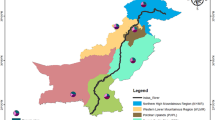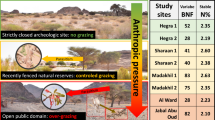Abstract
The South Aisikexiaer Cemetery, located in the Hami Basin of Xinjiang, northwest China, has been dated to around 2700 to 2400 bp. The arid conditions of the Hami region allow for the preservation through desiccation of a large amount of botanical materials, with 14 different taxa identified by systematic archaeobotanical study. Naked barley (Hordeum vulgare var. coeleste) was the only cereal type identified. Barley may be cultivated in the oases around the cemetery and threshed to obtain grains for foodstuff. Broken stems of barley were by-products of threshing and possibly consumed as binder for wall construction. Woody plants mainly include Populus euphratica, Tamarix sp. and Salix sp. Timbers of P. euphratica were the most important wooden materials for local inhabitants, used in the construction of tombs and fabrication of wooden articles. The remaining wild herbaceous plants are dominated by Aristida grandiglumis. Culms of A. grandiglumis may have been specially collected for livestock fodder and used as filling material of roof thatch on tomb. Stems of Phragmites australis were used in mat weaving. The diversity of plant remains, and their uses give insight into the adaptive strategies of the South Aisikexiaer population to arid environment in the Hami Basin during the early Iron Age.







Similar content being viewed by others
References
Bronk Ramsey C (2005) OxCal program v 3.10. Online: http://www.rlaha.ox.ac.uk/O/oxcal.php
Chang X (1989) Ancient tombs in Hami. In: CSA (Chinese Society of Archaeology), Chinese Archaeology Almanac. Cultural Relics Press, Beijing, pp 274–276 (in Chinese)
Chen G (1991) The instruction of the Yanbulake culture. W Reg Stud 1:81–96 (in Chinese)
Chen X (1995) Analysis of wood figurines discovered in the Gumugou cemetery. Huaxia Archaeol 2:71–77 (in Chinese with English abstract)
Chen G (1999) The supplementary instruction of the Yanbulake culture. Xinjiang Cult Relics 1:48–53 (in Chinese)
Cheng J, Yang J, Liu P (1992) Wood atlas of China. China Forestry Publishing House, Beijing (in Chinese)
Crivellaro A, Schweingruber F (2013) Atlas of wood, bark and pith anatomy of Eastern Mediterranean trees and shrubs: with a special focus on Cyprus. Springer, Berlin
Cui Y, Duan R, Zhou H, Zhu H (2002) Analysis of genetical structure of the ancient Xinjiang population. Chem Res Chin Univ 12:2278–2280 (in Chinese with English abstract)
Cui Y, Xu Y, Yang Y, Xie C, Zhu H, Zhou H (2004) Mitochondrial DNA polymorphism analysis of district of Lubunour at the Bronze Age in Xinjiang. J Jilin Univ (Med Ed) 4:650–652 (in Chinese with English abstract)
Doumani P, Frachetti M, Beardmore R, Schmaus T, Spengler R, Mar'yashev A (2015) Burial ritual, agriculture, and craft production among Bronze Age pastoralists at Tasbas (Kazakhstan). Archaeol Res Asia 1-2:17–32
Frachetti M (2012) Multiregional emergence of mobile pastoralism and nonuniform institutional complexity across Eurasia. Curr Anthropol 53(1):2–38
Frachetti M, Spengler R, Fritz G, Mar’yashev A (2010) Earliest direct evidence for broomcorn millet and wheat in the central Eurasian steppe region. Antiquity 84(326):993–1010
Gao L (2013) Comparative study of Siba culture Linya culture and protection analysis. Master thesis, Xinjiang Normal University, Urumchi (in Chinese with English abstract)
Han K (1986) Anthropological characters of the human skulls from the ancient cemetery at Gumugou, Xinjiang. Acta Archaeol Sin 3:361–384 (in Chinese with English abstract)
Han J (2005) The division of the Bronze Age and Early Iron Age in Xinjiang. Xinjiang Cult Relics 3:57–99 (in Chinese)
Harris R, Gosden C, Charles P (1996) Jeitun: recent excavations at an early Neolithic Site in Southern Turkmenistan. Proc Prehist Soc 62(124):423–442
Hou C (1985) Common millet, barley and valuable florets of bread wheat discovered in Loulan. Agric Archaeol 2:225–227 (in Chinese)
Hu R, Wang Y, Jiang F, Yang F, Zhao X (2003) Hami: a typical oasis group nourished by ground water in arid land. Arid Land Geogr 2:136–142 (in Chinese with English abstract)
Jiang H (2006) The plant remains of the Yanghai Tombs (2500 yrs B.P.) and their relationship to the ancient Yanghai people and environment. Doctoral thesis, Chinese Academy of Sciences, Beijing (in Chinese with English abstract)
Jiang H, Li X, Li C (2007) Cereal remains from Yanghai Tomb in Turpan, Xinjiang and their palaeoenvironmental significance. J Palaeogeogr 5:551–558 (in Chinese with English abstract)
Jiang H, Wu Y, Wang H, Ferguson D, Li C (2013) Ancient plant use at the site of Yuergou, Xinjiang, China: implications from desiccated and charred plant remains. Veg Hist Archaeobot 22:129–140
Jiang H, Zhang Y, Lu E, Wang C (2015) Archaeobotanical evidence of plant utilization in the ancient Turpan of Xinjiang, China: a case study at the Shengjindian cemetery. Veg Hist Archaeobotany 24:165–177
Li Y (1959) Painted potteries in Xinjiang. Archaeology 1-12:153–154 (in Chinese)
Li C, Li H, Cui Y, Xie C, Cai D, Li W, Mair V, Xu Z, Zhang Q, Yidilisi A, Jin L, Zhu H, Zhou H (2010) Evidence that a West-East admixed population lived in the Tarim Basin as early as the early Bronze Age. BMC Biol 8:15
Li Y, Li X, Cao H, Li C, Jiang H, Li C (2013) Grain remains from archaeological sites and development of oasis agriculture in Turpan, Xinjiang. Chin Sci Bull S1:40–45 (in Chinese with English abstract)
Lin M (2003) The origination and migration of Tocharian. W Reg Stud 3:9–23 (in Chinese)
Liu X (2008) The preliminary study of human figurines recovered in prehistoric Xinjiang. Huaxia Archaeol 3:86–92 (in Chinese with English abstract)
Liu H, Zhang Y, Xu X (1987) Ancient tombs of Kageqiake in Tuokexun of Xinjiang. Archaeology 7:597–603 (in Chinese)
Lu E, Chang X, Wang B (2001) The archaeological culture in the Bronze Age of Xinjian. In: Su B (ed) Su Bingqi and Chinese Archaeology. Science Press, Beijing (in Chinese)
Meng F (2011a) A brief history of the Silk Road. Social Science Academic Press, Beijing
Meng F (2011b) The local materials in traditional settlement-construction of ecology wisdom and enlightenment: a case study of representative regions of Xinjiang. Master thesis, Xi’an University of Architecture and Technology, Xian (in Chinese with English abstract)
Mu S, Wang M, Wang B (1983) The main discoveries in Xinjiang in thirty years (1949–1979). In: XIA (The Xinjiang Institute of Archaeology), archaeology in Xinjiang in recent thirty years (1949–1979). Xinjiang People’s Publishing House, Urumchi, pp 1–28 (in Chinese)
Reimer P, Baillie M, Bard E et al (2004) IntCal04—terrestrial radiocarbon age calibration, 0–26 cal kyr BP. Radiocarbon 46:1029–1058
Schröder O, Wagner M, Wutke S, Zhang Y, Ma Y, Xu D, Goslar T, Neef R, Tarasov P, Ludwig A (2016) Ancient DNA identification of domestic animals used for leather objects in Central Asia during the Bronze Age. The Holocene 26(10):1–8
Shao H (2007) The development of the pre-historic cultures in Xinjiang and the interaction with neighbour cultures. Doctoral thesis, Jilin University, Changchun (in Chinese with English abstract)
Shao H (2009) The cultural interaction between the East and West evidenced by the development of the prehistoric culture in Xinjiang. Soc Sci Front 9:146–150 (in Chinese)
Shui T (2001) A comparative study of Bronze Cultures in Xinjiang with a discussion of the process of early cultural exchange between the East and the West. In: Shui T (ed) Archaeological papers of the Bronze Age in Northwest China. Science Press, Beijing (in Chinese)
Spengler R, Frachetti M, Doumani P, Rouse L, Cerasetti B, Bullion E, Mar’yashev A (2014) Early agriculture and crop transmission among Bronze Age mobile pastoralists of Central Eurasia. Proc R Soc B Biol Scis 281(1783):20133382
Wang B (1983a) The agricultural archaeology in Xinjiang. Agric Archaeol 1:102–117 (in Chinese)
Wang B (1983b) Archaeological excavations at Gumugou site, Kongque River and a preliminary study on the discoveries. Xinjiang Soc Econ 1:117–127 (in Chinese)
Wang Y (1993) Cultural relics in Hami. Xinjiang People’s Publishing House, Urumchi (in Chinese)
Wang Z (1999) Reconstruction of Konghou (plucked stringed instrument). Cult Relics 7:50–60 (in Chinese with English abstract)
Wang B (2003) Konghou recovered in Zagunluke tomb of Xinjiang. Cult Relics 2:56–62 (in Chinese)
Wang Y, Dang Z (2011) New discoveries of the South Aisikexiaer Cmetery in Hami of Xinjiang. W Reg Stud 2:134–137 (in Chinese)
Wang B, Liu J, Mei Y, Zhang Y, Lu X (1989) Research on the barley unearthed from Wupu in Hami of Xinjiang. Agric Archaeol 1:71–75 (in Chinese)
Wang B, Chang X, Cui J (2003) A study on the races of the human skulls unearthed in the ancient tombs of northern slopes of Tianshan Mountains. J Xinjiang Norm Univ (Soc Sci) 1:97–107 (in Chinese with English abstract)
Wei D (2009) Human biological variation and population affinity during Bronze-Iron Age in Xinjiang Hami region. Doctoral thesis, Jilin University, Changchun (in Chinese with English abstract)
Wei D, Zhao Y, Chang X, Zhu H (2012) Craniometric variation of ancient skulls from the Hami Tianshan North Road Cemetery. Acta Anthropol Sin 4:395–406 (in Chinese with English abstract)
XIA (the Xinjiang Institute of Archaeology) (1984) The tombs of the late Neolithic Age in Lapuqiaoke of Hami. Archaeol Cult Relics 4:105–106 (in Chinese)
XIA (the Xinjiang Institute of Archaeology) (1992) Tomb 151 and 152 in Wupu of Hami. Xinjiang Cult Relics 3:1–10 (in Chinese)
Yang H, Jia M (2015) From Western Asia to Xinjiang: the diffusion route of Konghou. W Reg Stud 3:119–124 (in Chinese)
Yidilis A, Liu G, Li W (2004) The excavation report of Xiaohe cemetery. Res China’s Front Archaeol 3:338–398 (in Chinese with English abstract)
Yidilis A, Li W, Hu X (2007) A brief excavation report on Xiaohe graveyard located in Luobupo, Xinjiang Autonomous Region. Cult Relics 10:4–42 (in Chinese with English abstract)
Yisilafeier Y, Anniwaer H (2001) An ancient musical instrument Konghou. W Reg Stud 2:78–85 (in Chinese)
Yu X (1993) The cereals discovered in the tomb 152 in the Wupu cemetery of Hami. Agric Archaeol 3:185–189 (in Chinese)
Yu J (2008) A summary of archaeology in Hami. In: CRIH (Cultural Research Institute of Hami), Cultural research in Eastern Tianshan Mountains. Xinjiang People’s Publishing House, Urumchi, pp 61–70 (in Chinese)
Yu Z (2011) Archaeological discoveries from 2006 to 2010 in Xinjiang. China Cult Herit 4:44–51 (in Chinese)
Yu J (2012) Pre-historical millet crops from Xinjiang. W Reg Stud 3:71–75 (in Chinese with English abstract)
Zhang Y (1983) A brief introduction of cereals in ancient Xinjiang. Agric Archaeol 1:122–126 (in Chinese)
Zhang Y (1989) An overview of hunting and livestock husbandry in Xinjiang. Agric Archaeol 1:325–339 (in Chinese)
Zhang P, Aierken M, Tian Z, Feng X, Zhang T, Yao S, Xu Q, Guo J (1989) The Yanbulake Cemetery in Hami, Xinjiang. Acta Archaeol Sin 3:325–362 (in Chinese with English abstract)
Zhang G, Wang S, Ferguson D, Yang Y, Liu X, Jiang H (2017) Ancient plant use and palaeoenvironmental analysis at the Gumugou cemetery, Xinjiang, China: implication from desiccated plant remains. Archaeol Anthropol Sci 9(2):145–152
Zhao K, Li X, Zhou X, Dodson J, Ji M (2012) Characteristics of agricultural activities and its impact on the environment at Xintala site, Xinjiang, reconstructed from archaeological plant remains. Quat Sci 32(219–225):75 (in Chinese with English abstract)
Zheng C (1997) Local records of Hami region. Xinjiang University Press, Urumchi (in Chinese)
Zhou J, Yu J, Zhang C, Zhou X (2002) The excavation of the Aisikexiaer cemetery in Hami of Xinjiang. Archaeology 6:30–42 (in Chinese with English abstract)
Funding
This work was supported by the National Natural Science Foundation of China (41672171), “Special support fund for young scientists of scientific history studies” program of the Chinese Academy of Sciences (Y529027EA2), and fund from University of Chinese Academy of Sciences (Y65201YY00).
Author information
Authors and Affiliations
Corresponding author
Rights and permissions
About this article
Cite this article
Zhang, G., Wang, Y., Spate, M. et al. Investigation of the diverse plant uses at the South Aisikexiaer Cemetery (~ 2700–2400 years bp) in the Hami Basin of Xinjiang, Northwest China. Archaeol Anthropol Sci 11, 699–711 (2019). https://doi.org/10.1007/s12520-017-0563-9
Received:
Accepted:
Published:
Issue Date:
DOI: https://doi.org/10.1007/s12520-017-0563-9




